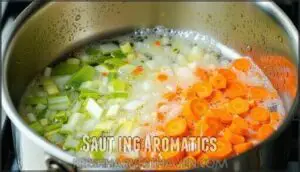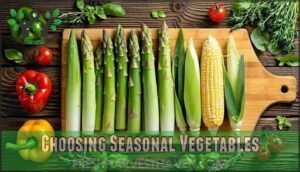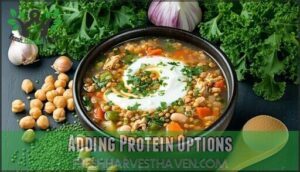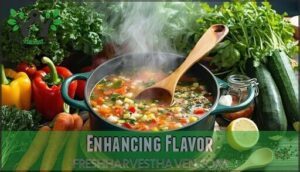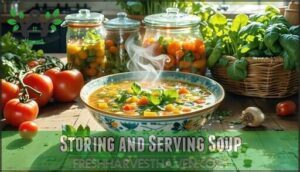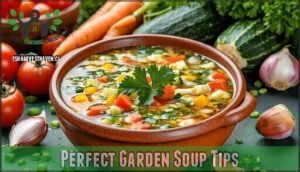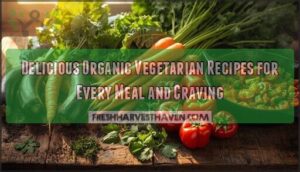This site is supported by our readers. We may earn a commission, at no cost to you, if you purchase through links.
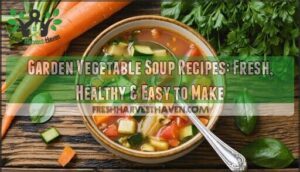 Garden vegetable soup recipes transform fresh produce into nourishing comfort food that’s surprisingly simple to master.
Garden vegetable soup recipes transform fresh produce into nourishing comfort food that’s surprisingly simple to master.
Start by sautéing aromatic vegetables like onions, carrots, and garlic in a large pot until fragrant. Add your favorite seasonal vegetables—think green beans, cabbage, zucchini, or tomatoes—along with vegetable or chicken broth.
Season with herbs like Italian seasoning, thyme, or basil, then simmer until vegetables reach tender perfection. The beauty lies in customization; you’ll discover countless variations using whatever’s growing in your garden or sitting in your fridge.
From storage secrets to flavor-boosting techniques, there’s more to creating the perfect bowl. The process involves understanding how to combine ingredients in a way that enhances the overall flavor and texture, making it a truly satisfying comfort food.
Table Of Contents
- Key Takeaways
- Garden Soup Basics
- Cooking Garden Soup
- Customizing Vegetable Soup
- Storing and Serving Soup
- Perfect Garden Soup Tips
- Frequently Asked Questions (FAQs)
- What is garden vegetable soup?
- What is homemade vegetable soup?
- How long does it take to cook a vegetable soup?
- What makes a good vegetable soup?
- What can I add to vegetable soup?
- How do you make a vegetarian soup?
- What vegetables are good for vegetable soup?
- What is in garden vegetable soup?
- What to add to vegetable soup to make it tasty?
- What makes vegetable soup taste better?
- Conclusion
Key Takeaways
- Build flavor layers by sautéing aromatics first – You’ll create the foundation by cooking onions, garlic, and carrots in olive oil until they are fragrant before adding broth and other vegetables.
- Customize with whatever’s available in your garden or fridge – You can swap vegetables based on seasons and what’s fresh, adding protein like beans or lentils to make it more filling.
- Time your vegetable additions based on their cooking needs – You’ll add harder vegetables like potatoes first, then softer ones like zucchini in the final minutes to prevent overcooking.
- Store properly for meal prep convenience – You can refrigerate for 4-5 days or freeze for 1-2 months, making it perfect for batch cooking and quick weekday meals.
Garden Soup Basics
You’ll create satisfying garden vegetable soup by mastering three fundamentals: selecting fresh, seasonal vegetables as your base, using proper sautéing and simmering techniques to build layers of flavor.
These core principles transform simple ingredients into a nourishing soup that captures the essence of your garden’s harvest, and incorporating herbs and acidic elements like lemon juice to brighten the final dish.
Core Ingredients
When building your garden vegetable soup, you’ll want a solid foundation of vegetables that work harmoniously together.
Start with aromatic base vegetables like onions, leeks, and garlic – they’re the flavor backbone of any great soup.
Fresh produce makes all the difference in taste and nutrient density, so choose crisp carrots, firm potatoes, and vibrant tomatoes when possible.
Your ingredient quality directly impacts the final flavor profiles, creating that satisfying depth you’re after, with a focus on using fresh produce.
Essential Cooking Techniques
Mastering these fundamental cooking techniques transforms your garden soup from bland to brilliant.
Proper sautéing vegetables creates the flavor foundation, while controlled simmering develops rich, complex tastes that make every spoonful satisfying.
- Sauté aromatics like onions and garlic in olive oil until fragrant
- Layer vegetables by cooking time, adding harder ones first
- Simmer gently for 20-30 minutes to develop deep flavors
- Control texture by monitoring vegetable tenderness throughout cooking
- Reduce broth slightly to concentrate flavors and achieve desired consistency
Flavor Enhancements
Transform your garden vegetable soup from ordinary to extraordinary with strategic flavor enhancements.
Fresh herbs like basil and parsley brighten every spoonful, while a miso addition provides an umami boost that deepens the broth’s complexity.
Fresh herbs and miso transform ordinary vegetables into restaurant-worthy soup perfection.
Add lemon juice just before serving for brightness that awakens all flavors, and utilize Homegrown herbs to guarantee superior freshness.
These herb additions and miso seasoning create restaurant-quality results, leading to a more enjoyable and refined dining experience.
Cooking Garden Soup
Once you’ve prepped your vegetables, you’re ready to transform them into a flavorful soup through proper cooking techniques.
The key lies in building layers of flavor by sautéing aromatics first, then adding broth and simmering everything to perfection.
Sautéing Aromatics
Start with olive oil heated in your stockpot over medium-low heat. Add leeks and garlic first, letting them sweat until softened—this builds your flavor foundation.
Next, toss in carrots and sauté for four to five minutes, stirring occasionally. This gentle cooking prevents burning while developing those essential aromatics that’ll make your soup sing.
Consider using high quality olive oil for the best flavor.
Adding Broth
Once your aromatics release their fragrance, pour in your chosen broth to create the soup’s foundation.
Vegetable broth offers lighter flavor intensity, while chicken broth provides richer depth.
Consider sodium content when selecting store-bought options, or use homemade broth for complete control over taste and ingredients.
Different broth types dramatically impact your soup’s final character.
Fresh vegetables also offer significant nutritional benefits, which is a complete concept to consider for a healthy and balanced meal.
Simmering Methods
After bringing your broth to a rapid boil, reduce heat to maintain a gentle simmer that preserves delicate flavors.
This simmering method guarantees proper texture control while maximizing nutrient retention.
Cover partially to encourage broth reduction and concentrated flavor infusion. Your vegetables will cook evenly through consistent, low-heat simmering soup techniques, which aids in nutrient retention.
Customizing Vegetable Soup
You can transform basic garden vegetable soup into countless variations by swapping ingredients based on what’s fresh in your kitchen or garden.
The beauty of vegetable soup lies in its flexibility—you’ll never get bored when you know how to customize it with seasonal produce, protein additions, and flavor boosters.
Choosing Seasonal Vegetables
You’ll discover peak flavors when you match garden vegetable soup ingredients with seasonal availability.
Spring’s peas and asparagus offer maximum nutrient density, while summer brings sweet corn and tomatoes.
Local sourcing during garden harvest season cuts costs by 33% and boosts vitamin content. Garden planning around seasonal vegetables guarantees your soup captures nature’s best timing for maximal taste and nutrition.
For best results, remember to sauté vegetables first to enhance their flavors and ensure a hearty seasonal vegetable soup.
Adding Protein Options
You can boost your soup’s nutrition with various protein additions.
Lentils provide up to 21g protein per serving and cook quickly.
White beans deliver 15g protein while adding creamy texture.
Chickpeas offer complete amino acids when paired with quinoa.
For heartier options, add shredded chicken or ground turkey.
Greek yogurt stirred in creates richness with extra protein.
For a silky and creamy finish, consider adding dairy for protein to enhance the overall nutrition.
Enhancing Flavor
Transform your garden soup from bland to brilliant with strategic flavor building. Fresh herbs, aromatic spices, and umami-rich additions create depth that keeps everyone coming back for seconds.
- Herb combinations: Pair basil with parsley, or thyme with oregano for complex flavor layers
- Miso addition: Stir in white miso paste before serving for instant savory richness
- Broth selection: Choose low-sodium vegetable or chicken broth as your flavorful foundation
- Lemon brightness: Add fresh lemon juice just before serving to awaken all ingredients
Storing and Serving Soup
You’ve made a delicious batch of garden vegetable soup, and now it’s time to store it properly so you can enjoy it for days to come.
Proper storage techniques will keep your soup fresh and safe, while smart reheating methods guarantee every bowl tastes just as good as the first, ensuring a great overall experience.
Refrigeration Methods
Proper cooling techniques guarantee your garden vegetable soup stays fresh and safe.
Transfer cooled soup into airtight container types within two hours of cooking.
Refrigerator placement on middle shelves maintains consistent temperature for ideal soup storage.
Your soup’s shelf life extends four to five days when stored correctly.
Watch for spoilage signs like sour odors or mold before consuming leftovers, ensuring the soup remains safe.
Freezing and Reheating
Freezing soup opens up meal prep possibilities, though you’ll want to cool it completely first.
Potatoes may change texture slightly after thawing, becoming softer but still flavorful.
Best Practices for freezing soup:
- Cool completely before transferring to freezer-safe containers
- Leave headspace (1-2 inches) for expansion during freezing
- Label containers with date and contents for organization
- Use within 1-2 months to prevent freezer burn and nutrient loss
- Reheat gently on stovetop or microwave, stirring occasionally
Safe reheating involves bringing soup to 165°F internal temperature.
Frozen portions thaw overnight in the refrigerator for even heating.
Nutrition Facts
Your bowl delivers impressive nutrition with just 80-120 calories per serving.
You’ll get 3-4 grams of fiber for digestive health, plus vitamin A and C from colorful vegetables.
Protein ranges from 2-4 grams, while sodium levels vary from 130-790mg depending on preparation.
To maintain freshness, consider proper humidity levels after harvesting.
This hydrating meal supports weight management through its high water content and satisfying fiber benefits that keep you full longer, providing digestive health.
Perfect Garden Soup Tips
You’ll master garden vegetable soup by following a few key techniques that transform basic ingredients into restaurant-quality results.
These proven methods help you avoid common pitfalls while building layers of flavor that make your soup memorable.
Step-by-Step Guide
Start by chopping all vegetables uniformly for even cooking.
Heat olive oil, then sauté onions and garlic until fragrant. Add harder vegetables like carrots and potatoes first, cooking for several minutes.
Pour in broth, bring to a boil, then reduce heat. Add softer vegetables and simmer covered for 25-30 minutes until tender.
Using a vegetable chopper speeds this process. Finish with fresh herbs.
Achieving Rich Flavor
Building on your solid technique, rich flavor comes from smart ingredient choices and timing.
Smart timing with quality ingredients separates good soup from unforgettable soup.
Your homemade vegetable soup transforms from simple to spectacular with these flavor-boosting moves:
- Umami Boost: Add white miso or nutritional yeast for deep, savory notes
- Herb Infusion: Layer fresh herbs throughout cooking, not just as garnish
- Acid Balance: Finish with lemon juice to brighten your vegetable broth
Quality seasoning and broth selection make ordinary garden vegetable soup extraordinary.
Homegrown vegetables offer superior nutrient density, enhancing the soup’s health benefits.
Troubleshooting Issues
Everyone faces challenges when crafting garden soup, but most issues have simple fixes.
When vegetables turn soggy, you’ve likely overcooked them—add delicate ingredients during final minutes.
Bland flavor means you need more seasoning or aromatics.
Over-salting requires diluting with unsalted broth.
| Problem | Quick Solution |
|---|---|
| Soggy Vegetables | Add tender veggies last 5-10 minutes |
| Bland Flavor | Boost with herbs, lemon juice, or miso |
| Bitter Taste | Balance with sweet vegetables or honey |
Texture problems often stem from uneven cooking—cut vegetables uniformly.
Adjust soup thickness by simmering uncovered to reduce liquid or adding broth to thin.
When you reheat leftovers, warm gently to preserve texture and nutrients.
To achieve the best results, consider the simple fixes and quick solutions provided, and always aim for a balance of flavors to avoid a bitter taste.
Frequently Asked Questions (FAQs)
What is garden vegetable soup?
Garden vegetable soup combines fresh seasonal vegetables like carrots, potatoes, green beans, tomatoes, and corn in a flavorful broth. You’ll create a nutritious, hearty meal that’s endlessly customizable.
What is homemade vegetable soup?
Picture vibrant vegetables dancing in a bubbling pot as aromatic steam rises.
You’re crafting homemade vegetable soup by simmering fresh ingredients like carrots, potatoes, and green beans in flavorful broth until tender.
How long does it take to cook a vegetable soup?
You’ll spend about 40 minutes actively preparing and cooking vegetable soup, with total time reaching 1 hour 25 minutes including simmering. Most recipes need 20-30 minutes of gentle cooking once everything’s combined.
What makes a good vegetable soup?
A symphony of flavors starts with proper layering: sauté aromatic vegetables first, add heartier ones early, incorporate delicate greens last, and finish with fresh herbs and lemon juice.
What can I add to vegetable soup?
You can boost vegetable soup with protein additions like white beans, lentils, or quinoa.
Try grains such as pasta, barley, or rice for heartiness.
Fresh herbs, miso paste, and lemon juice brighten flavors beautifully, with lemon juice being a key addition.
How do you make a vegetarian soup?
Like Julia Child mastering French cuisine, you’ll start with olive oil and aromatics—onions, garlic, carrots.
Add vegetable broth, then layer in potatoes, beans, tomatoes, and corn.
Simmer until tender, finish with fresh herbs.
What vegetables are good for vegetable soup?
You’ll want hearty root vegetables like carrots, potatoes, and onions as your foundation. Add green beans, zucchini, tomatoes, and corn for color and texture variety.
What is in garden vegetable soup?
Fresh from nature’s pantry, you’ll find potatoes, carrots, green beans, corn, tomatoes, leeks, and garlic creating this wholesome medley. Each spoonful delivers garden-fresh vegetables simmered in flavorful broth with herbs.
What to add to vegetable soup to make it tasty?
Add fresh herbs like basil and parsley, a splash of lemon juice for brightness, and sauté your aromatics properly.
Consider white miso for umami depth, or stir in beans for heartiness.
What makes vegetable soup taste better?
A good soup is like a symphony – every ingredient plays its part.
You’ll enhance flavor by building layers: sauté aromatics first, season throughout cooking, and finish with fresh herbs and lemon juice for brightness.
Conclusion
Just like Julia Child transformed simple ingredients into culinary masterpieces, you’ll find that garden vegetable soup recipes turn humble produce into satisfying comfort food.
These versatile recipes adapt to whatever vegetables you have on hand, from summer zucchini to winter root vegetables.
You can customize flavors with herbs, adjust textures through cooking time, and boost nutrition with protein additions.
With proper storage techniques, you’ll have healthy meals ready whenever you need them, and master these garden vegetable soup recipes once, and you’ll create countless delicious variations.
- https://www.olgasflavorfactory.com/summer-favorites/garden-vegetable-soup/
- https://createmindfully.com/garden-vegetable-soup/
- https://aspenvalleyhealth.org/healthy-journey/healthy-vegetable-soups/
- https://veggiesociety.com/garden-vegetable-soup-recipe/
- https://www.inspiredtaste.net/37646/vegetable-soup-recipe/

